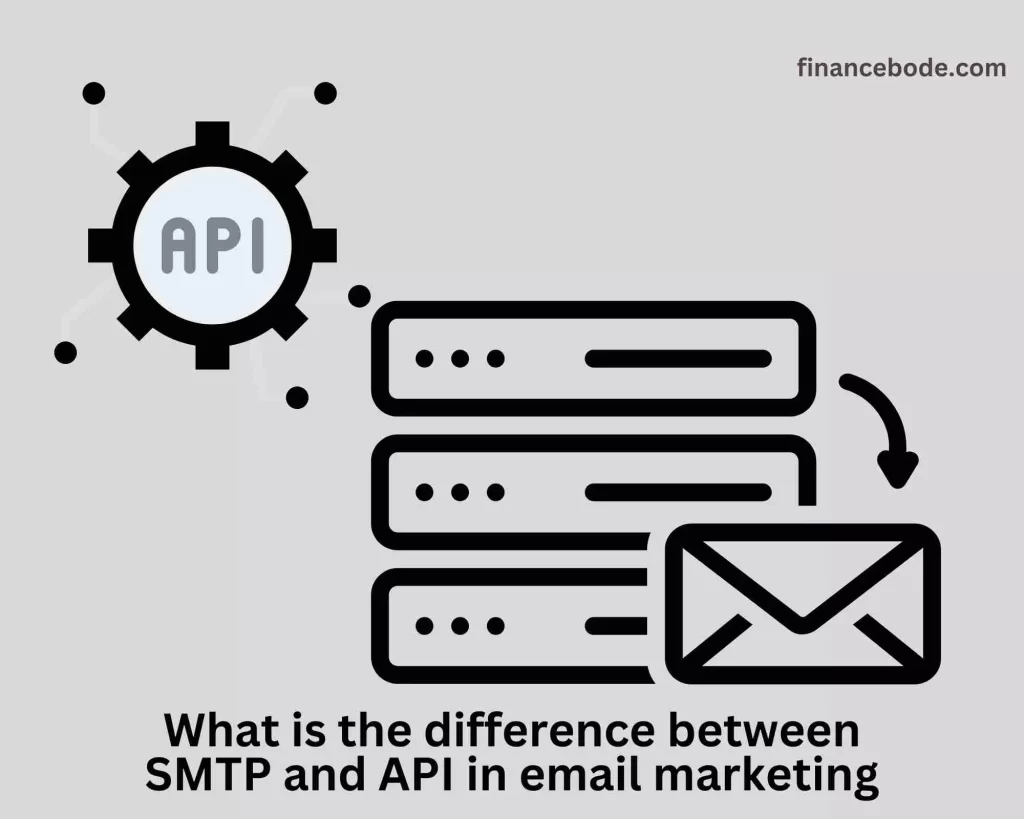What is the difference between SMTP and API in email marketing? SMTP (Simple Mail Transfer Protocol) and API (Application Programming Interface) are two different methods of sending emails in email marketing.
While both are crucial in sending and receiving emails, they have different functions. They work almost the same, but they have significant differences. SMTP is used to send emails, while API is used to automate email marketing campaigns by integrating different applications.
In Email marketing, you must have heard of the concept of SMTP and API. But should email be sent via SMTP or API?
In this article, I will help you distinguish SMTP and API differently in email marketing. But first, let’s have a basic knowledge of the 2 terms.
What Is SMTP?
What is SMTP? SMTP stands for Simple Mail Transfer Protocol. This is the fundamental standard that mail servers use to transmit emails to one another over the internet.
SMTP is responsible for transferring emails from the sender’s email server to the recipient’s email server. It provides the foundation for email communication, making it possible for email messages to be sent and received across the internet.
Learn more: What is SMTP Server?
SMTP is also used by email clients like Apple Mail, Gmail and Outlook to send and receive emails to the server. Then forward them to other mail servers.
How Is SMTP Used?
How is SMTP used? As noted previously, SMTP has a particular function, and that is email. It maintains the security of communications in transit between sender and recipient.
The procedure of sending emails via SMTP is pretty straightforward. When a client program wants to send an email, it starts a connection to the SMTP server. SMTP will listen for TCP connections and start binding to that port.
Port 587 is considered the default SMTP port for mail transport. This is the port you should use unless prohibited by your network or provider.
Who Is SMTP For Then?
Who is SMTP for, then? SMTP is a wonderful choice for casual email senders who do not send mass emails. SMTP also has its virtues and faults. It is definitely easier to use.
SMTP is generally used; therefore, it may also be linked with currently existing applications, such as CRM systems. So, if you aren’t a developer who builds their own app, SMTP may be something for you.
Next, we learn about API knowledge to clearly distinguish the difference with SMTP.
What Are APIs?
API stands for Application Programming Interface. Unlike SMTP, it’s not simply for email. It is a way through which various programs, platforms, software, and code may interact and share resources with one another.
An Email API allows programs access to features offered in the email platform. Such as developing and updating templates; Sending transaction emails (Email confirmation, activation); Allows access to email analytics.
In email marketing, APIs enable businesses to connect their email marketing software to other platforms, such as CRMs or e-commerce platforms, to send automated and targeted emails to customers.
APIs provide businesses with the ability to automate their email marketing campaigns, making it easier to send personalized and relevant emails to customers based on their behaviour and preferences.
With APIs, businesses can track customer interactions and tailor their email marketing campaigns based on their Customer’s interests and behaviour.
How Is The Email API Used?
The email API is majorly used to send transactional messages straight from your own app or website. It also offers you simple access to a range of analytics. For example, the Total number of emails sent, number of messages rejected by ISP (and reason), open and click rates….
For example, an e-commerce website or mobile app has incorporated the Email Service Provider API. The steps to send a transaction email are as follows:
1. Customers make a purchase on an e-commerce site or change the password of the mobile app.
2. The e-commerce site or application will interface with the API gateway and supply information such as the Customer’s email address, details of the transaction or password reset, etc.
3. The Email Service Provider creates alerts with the aforementioned information based on pre-designed templates for each specified purpose. (The purchase email template is different from the password reset form). And sent to the Customer’s mailbox.
4. ESP captures the details of the mailing procedure. Such as email sending success or error, Reports whether opened, clicked, etc. This information will be updated in the dashboard.
All email APIs work similarly to the example above. Their purpose is to provide fast, consistent capability without the hassle of using separate services or software.
Who Is Email API For Then?
Email API is surely an excellent alternative for application developers. Not only do they have no trouble with the integration procedure, but even accessing the API documentation is not a barrier for them.
It may be an optimum alternative for experienced marketers who have some coding skills. Email API is also a wonderful choice for mass email senders owing to its high deliverability and rAPId deliver
Distinguish The Difference Between SMTP And API In Email
What is the difference between SMTP and API in email? Both SMTP and API are critical components of email marketing, yet they serve distinct purposes. The SMTP protocol is in charge of delivering and receiving email messages, while the API is used to automate and customize email campaigns.
SMTP is a necessary component of email marketing because it provides the foundation for email communication. Email communications cannot be transmitted or received over the internet without SMTP. SMTP guarantees that emails are sent to the recipient’s email server and handles any faults or problems that may occur during the transmission process.
API, on the other hand, is used to automate and customize email marketing messages for specific clients. Businesses may use APIs to link their email marketing software to other platforms and measure consumer interactions. This helps organizations to build customized and relevant email marketing depending on the behaviour and interests of their consumers.
When To Use SMTP For Email?
The best time to make use of SMTP in the email will be when utilizing applications produced by third parties or platforms/apps that cannot integrate APIs.
You may use SMTP to transact or send mass emails. The negative of SMTP is that it tends to be slower than the API since there’s a lot of “talk” between the servers.
This might lead to reduced performance of postal delivery. In addition, utilizing SMTP, the email must include DNS, along with sender authentication criteria.
When To Use API For Email?
I recommend using the Email API in practically every case, where you may incorporate it into your apps.
They have the advantage of being faster and more flexible than SMTP. As you can see, the API is commonly used for websites that need automatic email activation. E.g.:
- Notice of account creation
- Reset Password
- Suspicious login message
In addition, APIs may allow your platform to behave in different ways with respect to its own preset triggers. This enables fluidity and flexibility in the operation of your website or platform. For example:
- Application error message
- Purchase receipt
- Shipping Notice
- policy notification
Things To Remember About SMTP And API
SMTP and API might be complicated, but you need to know the difference to determine the best moment to utilize them.
- As the name says, it deals with mail transmission. You should use it to send emails when you have applications that don’t enable the API functionality.
- Allows consumer actions to trigger email automatically. Recommended for when you need to send emails quickly and demand flexibility.
Now you know a little more about what SMTP is and what API is. Make your decision using the proper form with confidence.
Conclusion
In the project I do presently, I utilize SMTP and 3rd party API; maybe in the near future, I will build up my own system’s SMTP to use. But for now, using SMTP and 3rd party API is still reasonable.
SMTP and API might be complicated, but you need to know the difference to determine the best moment to utilize them. Here is a recap of the difference between them.
I hope the above sharing will partially help you answer your problems and determine how to utilize the two kinds to send emails.
FAQs About SMTP and API in Email Marketing
Can SMTP and API be used in email marketing together?
Yes, SMTP and API may both be used in email marketing. As explained earlier, The SMTP protocol is used to send and receive email messages, while the API protocol is used to automate and customize email campaigns. Businesses may build targeted and relevant email marketing that connects with their consumers by combining the two, improving the possibility of conversions and purchases.
Is SMTP more important than API in email marketing?
Both SMTP and API are important in email marketing, though they serve distinct purposes. The SMTP protocol is required for sending and receiving email messages, but the API protocol is utilized to automate and customize email campaigns. Both are essential in developing effective email marketing initiatives.
How do businesses benefit from using SMTP and API in email marketing?
Businesses benefit from email marketing utilizing SMTP and API because they can design focused and relevant email campaigns that resonate with their consumers. Businesses may boost the chance of conversions and sales by automating email messages and tailoring them based on consumer behaviour and preferences.
Can businesses use email marketing without SMTP and API?
No, email marketing cannot be used by businesses without SMTP and API. The SMTP protocol is required for sending and receiving email messages, but the API protocol is utilized to automate and customize email campaigns. Businesses would be unable to send or receive email messages, as well as automate and customize their email marketing campaigns, without these components.





